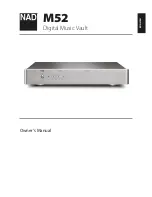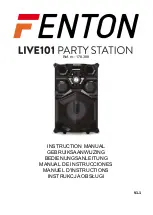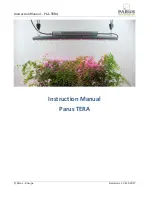
4. conTenTS
5. oPeraTIon
5.1.
general noTeS
WarnIng!
Ensure you have read and understood the safety instructions.
5.1.1.
Check the tyre for physical signs of damage.
noTe:
If the hole or tear is greater than 6mm it is probably too big to fix. Consider seeking assistance.
8
Do noT
pull out any objects stuck in the tyre, this might make the repair harder to achieve.
noTe:
If possible, work on the tyre with the hole/tear near to the lower most point of the tyre. The sealant will work better that way.
noTe:
When inflating/repairing a totally flat tyre still fitted on a vehicle, there should not be any weight on it. The vehicle must,
therefore, be jacked up to take the weight off the tyre. Review jack safety instructions and vehicle manufacturer’s guidelines for
jacking.
5.1.2.
Position compressor on a firm, flat surface and located so that the air hose reaches the tyre valve.
ImPorTanT:
Inflation will only be effective if the connectors are fully fitted.
WarnIng!
The compressor must be switched off for twenty minutes after each twenty minute period of continuous operation to
prevent excessive heat build-up.
5.2.
PuncTure rePaIr
noTe:
Review Section 5.1 before beginning this process.
5.2.1.
Unpack the unit and check that all items are present and in good working condition.
5.2.2.
Check that the compressor On/Off switch is in the OFF position and plug the 12V plug into the vehicle’s accessory socket.
5.2.3.
Gently shake the sealant bottle to mix it thoroughly.
ImPorTanT:
Repair will only be effective if the connectors are correctly fitted.
5.2.4.
Connect air hose (fig.1.6) to sealant air inlet connector (fig.1.1)
5.2.5.
Invert sealant bottle and locate into face of compressor (fig.1.2). Rotate clockwise to lock in place.
5.2.6.
Connect sealant outlet (fig.1.7) to tyre valve.
5.2.7.
Turn the compressor on to begin the process. Once the tyre reaches the required pressure turn the compressor off.
noTe:
If the tyre has not inflated after approximately 10 minutes check all connections for leakage / blockage. If none is evident
consider seeking assistance.
noTe:
If the tyre is accidentally over-inflated, use the relief valve on air hose (fig.1.6) to allow air out of the tyre.
WarnIng!
After repairing the tyre, the air hose and its connectors may be hot. Leave to cool for 2 to 3 minutes before removing.
5.2.8.
Remove all fittings and the power supply. Stow the items in carry case and place used sealant bottle in a leak-proof bag if available.
5.2.9.
Drive for about 2 miles (~3km) so that sealant can seal the damaged area. Stop and check tyre pressure, top up tyre pressure if
required.
8
Do noT
drive faster than 50mph (80kph) on the repaired tyre.
8
Do noT
drive further than 125 miles (200km) on the repaired tyre.
8
Do noT
continue driving if any vibrations, unsteady steering or noises occur. Consider seeking assistance.
5.3.
Tyre / InflaTaBleS InflaTIon
noTe:
Review Section 4.1 before beginning this process.
5.3.1.
Check that the compressor On/Off switch is in the OFF position and plug the 12V plug into the vehicle’s accessory socket.
5.3.2.
Remove the valve dust cap and screw the connector onto the valve stem.
ImPorTanT:
Inflation will only be effective if the connector is fully fitted onto the valve.
5.3.3.
Press the compressor On/Off switch to the ON position and the compressor will begin to operate.
5.3.4.
Inflate the tyre to the desired pressure and turn off the compressor by pressing the switch to the OFF position.
noTe:
The gauge may be subject to fluctuation whilst pumping.
5.3.5.
Remove the air hose from the tyre valve by unscrewing connector from the tyre valve, taking care to minimise air loss in the
process. Replace the dust cap.
5.3.6.
Disconnect the 12V plug from the vehicle’s accessory socket.
noTe:
The pressure gauge is not a calibrated instrument. It is recommended to use a calibrated tyre pressure gauge for an
accurate final reading.
noTe:
The compressor may also be used on items such as inflatable dinghies, sports balls, air beds etc. using one of the two
adaptors supplied.
noTe:
If the tyre/inflatable is accidentally over-inflated, use the relief valve on air hose (fig.1.6) to allow air out.
cauTIon:
Some items may not indicate the pressure required or the safe maximum pressure. Be very careful not to over-inflate.
6. maInTenance
6.1.
Before each use check all hoses and fittings are sound and serviceable.
6.2.
Wipe down unit with damp cloth and dry thoroughly if soiled.
Do noT
get the unit wet.
6.3.
Replace all hoses back into relative compartments in compressor body and place
M
AC10S Issue 1 31/10/19
Original Language Version
© Jack Sealey Limited
item
no.
d
escription
item
no.
d
escription
1
Connector - air inlet
5
Power cable
2
S
ealant location
6
Air hose + deflation valve
3
o
n / Off switch
7
Tyre valve
Connector
4
Pressure gauge
fig.1





















